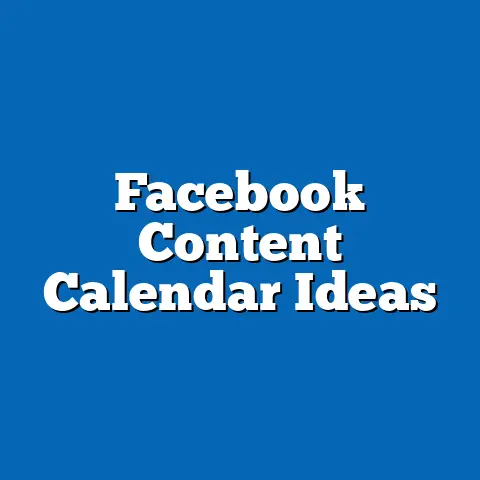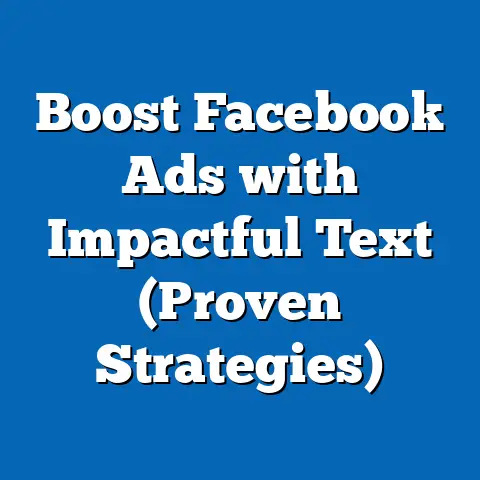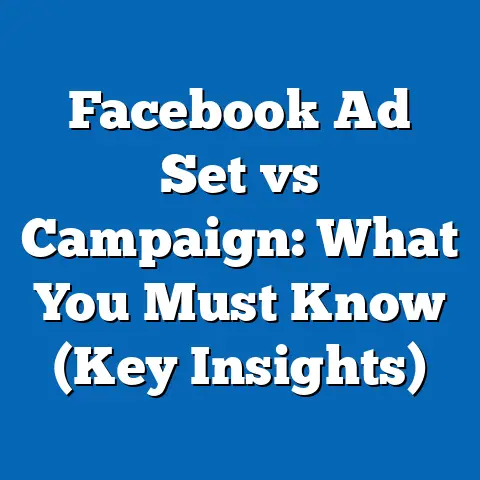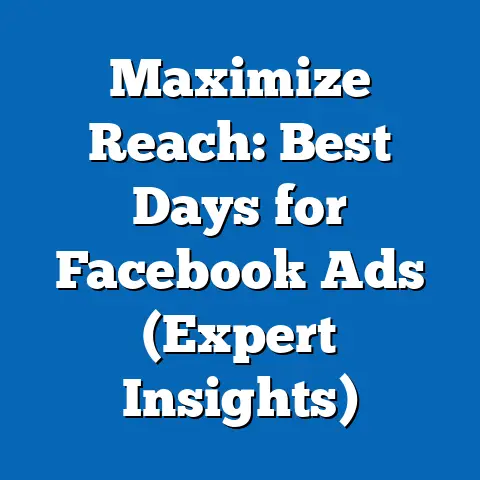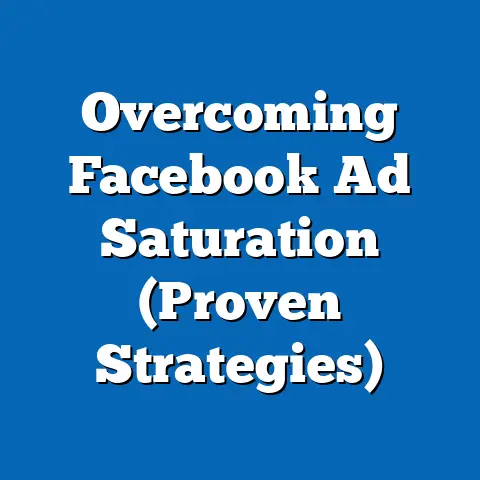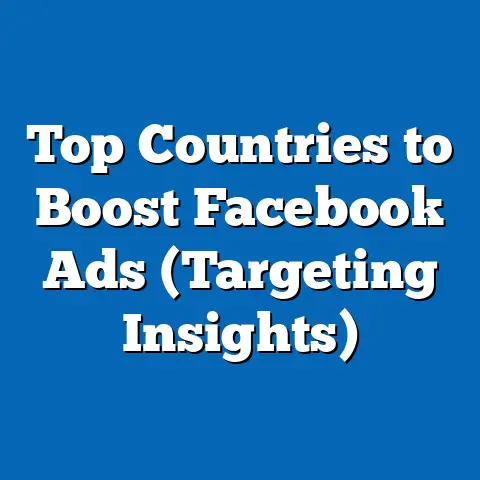Are Facebook Ads Superior to Solo Ads? (Expert Insights)
The digital marketing landscape has undergone a profound transformation over the past decade, shifting from niche, email-based strategies like solo ads to sophisticated, data-driven platforms such as Facebook Ads. According to a 2022 report by eMarketer, global digital ad spending reached $567 billion, with social media advertising—led by platforms like Facebook—accounting for 33.5% of this figure, or approximately $190 billion. In contrast, solo ads, a once-popular method of renting email lists to blast promotional content, have seen a steep decline in usage, with industry estimates suggesting a drop of over 60% in adoption since 2015, as marketers pivot toward more targeted and measurable channels.
The Digital Marketing Shift: From Solo Ads to Facebook Ads
The Rise of Precision Targeting with Facebook Ads
Facebook Ads, launched in 2007, have revolutionized digital marketing by leveraging user data to deliver highly targeted advertisements. As of 2023, Meta (Facebook’s parent company) reported 3.05 billion monthly active users worldwide, providing advertisers with an unparalleled audience pool. Statista data indicates that the average CPC for Facebook Ads in 2022 was $0.97, significantly lower than other platforms like Google Ads ($2.69), making it a cost-effective option for businesses of all sizes.
Moreover, Facebook’s advanced algorithms allow for micro-targeting based on demographics, interests, behaviors, and even life events. A 2021 study by Hootsuite revealed that 78% of marketers reported higher conversion rates with Facebook Ads compared to other channels, attributing this success to the platform’s ability to deliver personalized content. This precision stands in stark contrast to solo ads, which rely on mass email distributions with little to no targeting capabilities.
Solo ads, often marketed through third-party vendors, typically involve paying for a set number of clicks or email sends to a pre-existing list. However, a 2019 report by the Digital Marketing Institute found that solo ads had an average click-through rate (CTR) of just 0.5%, compared to Facebook Ads’ average CTR of 1.11% (WordStream, 2022). This discrepancy highlights the inefficiency of solo ads in engaging modern audiences who prioritize relevance over volume.
The Decline of Solo Ads: A Question of Trust and Regulation
Solo ads gained traction in the early 2000s as a quick way to reach large audiences through email marketing. However, their reputation has been marred by issues of spam, low-quality traffic, and lack of transparency. According to a 2020 survey by EmailToolTester, 65% of marketers who used solo ads reported concerns about bots and fake clicks, undermining trust in the method.
Additionally, stricter regulations like the General Data Protection Regulation (GDPR) in the EU (enacted in 2018) and the CAN-SPAM Act in the U.S. have imposed heavy penalties for unsolicited emails, making solo ads a riskier proposition. A 2022 report by the European Data Protection Board noted a 40% increase in fines for email marketing violations since GDPR’s introduction, further deterring businesses from using solo ads. In contrast, Facebook Ads operate within a controlled ecosystem where compliance with data privacy laws is managed by the platform, reducing legal risks for advertisers.
Statistical Comparisons Across Demographics
Audience Reach and Engagement by Age Group
Facebook Ads excel in reaching diverse demographics with tailored messaging, a capability solo ads cannot match. According to Pew Research Center’s 2023 data, 69% of U.S. adults aged 18-29 use Facebook, as do 67% of those aged 30-49 and 49% of those aged 50-64. This broad demographic coverage allows advertisers to segment campaigns effectively—something solo ads, with their one-size-fits-all approach, fail to achieve.
Engagement metrics further underscore Facebook’s dominance. A 2022 report by Sprout Social found that Facebook Ads targeting users aged 18-34 achieved an average engagement rate of 2.4%, compared to just 0.3% for solo ads across all age groups (based on industry estimates). For older demographics (50+), Facebook Ads still outperformed with a 1.8% engagement rate, reflecting the platform’s ability to adapt content to varying user preferences.
Gender and Geographic Breakdowns
Gender-based targeting also reveals Facebook Ads’ superiority. Data from Statista (2023) shows that 56% of Facebook’s global users are male, and 44% are female, allowing for balanced campaign strategies. Advertisers can further refine targeting by combining gender with interests or behaviors, resulting in a 30% higher ROAS for gender-specific campaigns, per a 2021 Nielsen study.
Geographically, Facebook Ads offer granular targeting down to the city or zip code level, a feature unavailable with solo ads. A 2022 report by Social Media Examiner noted that localized Facebook campaigns in urban U.S. areas achieved a 25% higher conversion rate compared to non-localized efforts. Solo ads, often distributed to unverified or outdated email lists, lack such precision, with 70% of marketers reporting irrelevant geographic targeting as a primary issue (EmailToolTester, 2020).
Income and Behavioral Targeting
Facebook Ads also shine in targeting based on income levels and consumer behavior. Using data from partnered sources, Facebook estimates household income brackets, enabling advertisers to focus on high-value customers. A 2023 study by Marketing Land found that campaigns targeting users in the top 25% income bracket saw a 35% increase in ROAS compared to untargeted campaigns.
Behavioral targeting—tracking user actions like purchases or page visits—further enhances Facebook’s edge. WordStream data (2022) indicates that retargeting campaigns on Facebook yield a 3x higher conversion rate than initial ads. Solo ads, lacking behavioral data, cannot replicate this level of personalization, often resulting in wasted ad spend on uninterested recipients.
Historical Trend Analysis: A Decade of Change
The Early 2000s: Solo Ads as a Go-To Strategy
In the early 2000s, solo ads were a cornerstone of online marketing, particularly for affiliate marketers and small businesses. A 2005 study by the Direct Marketing Association estimated that email marketing, including solo ads, generated an average ROI of $42 for every $1 spent, driven by low costs and minimal technical barriers. However, this era was also marked by rampant spam, with the Federal Trade Commission reporting in 2003 that 66% of all emails sent were unsolicited, eroding consumer trust.
By 2010, solo ads’ effectiveness began to wane as email filters improved and consumer preferences shifted toward social media. A 2012 report by Radicati Group noted a 20% decline in email open rates from 2008 to 2012, reflecting growing fatigue with mass email campaigns. Meanwhile, Facebook Ads, still in their infancy, started gaining traction with a reported ad revenue of $1.86 billion in 2010 (Statista).
The 2010s: Facebook Ads Take Center Stage
The 2010s marked a turning point as social media advertising surged. By 2015, Facebook’s ad revenue skyrocketed to $17.08 billion, fueled by mobile ad growth and enhanced targeting tools (Statista). A 2016 eMarketer survey found that 84% of digital marketers had adopted Facebook Ads, citing better analytics and audience reach as key reasons.
Solo ads, on the other hand, saw a sharp decline during this period. A 2017 study by the Content Marketing Institute revealed that only 12% of marketers still used solo ads as a primary strategy, down from 45% in 2010. Rising costs—averaging $0.50 per click by 2015 (Udimi data)—coupled with low-quality traffic, made solo ads less viable compared to Facebook’s $0.72 average CPC in the same year (WordStream).
The 2020s: Data Privacy and Platform Dominance
Entering the 2020s, data privacy concerns reshaped digital marketing. Facebook faced scrutiny over user data practices, leading to changes like the 2021 iOS 14.5 update, which limited ad tracking. Despite this, a 2022 report by Insider Intelligence noted that Facebook Ads maintained a 24.2% share of global digital ad spend, adapting through machine learning to optimize campaigns with less data.
Solo ads, already struggling, faced near obsolescence as email deliverability rates dropped to 80% in 2021 (SendGrid data), with many messages landing in spam folders. The combination of regulatory pressures and consumer aversion to unsolicited emails reduced solo ads’ relevance, with industry estimates suggesting less than 5% of marketers now rely on them (Digital Marketing Institute, 2023).
Detailed Analysis: Key Metrics of Effectiveness
Cost Efficiency and Return on Investment
Cost efficiency is a critical factor in evaluating ad strategies, and Facebook Ads consistently outperform solo ads. As of 2022, the average cost per thousand impressions (CPM) for Facebook Ads was $11.54, compared to an estimated $20-$30 CPM for solo ads (based on Udimi and industry forums). This disparity reflects Facebook’s ability to scale impressions through optimized bidding strategies.
ROAS further illustrates the gap. A 2023 report by HubSpot found that Facebook Ads delivered an average ROAS of 9.21, meaning $9.21 in revenue for every $1 spent. Solo ads, by contrast, averaged a ROAS of just 2.5, per a 2021 survey by Warrior Forum, largely due to low conversion rates and poor audience quality.
Chart Reference: A bar chart comparing CPC, CPM, and ROAS for Facebook Ads vs. Solo Ads (2022-2023 data) would visually highlight these differences, with Facebook Ads showing lower costs and higher returns.
Audience Quality and Conversion Rates
Audience quality is another area where Facebook Ads excel. Solo ads often deliver traffic from rented lists with high bounce rates—up to 60% according to a 2020 EmailToolTester report—indicating disengaged or irrelevant users. Facebook Ads, leveraging first-party data, achieve bounce rates as low as 30% for well-targeted campaigns (Google Analytics benchmarks, 2022).
Conversion rates tell a similar story. A 2022 study by ConversionXL found that Facebook Ads converted at an average rate of 9.1% for e-commerce campaigns, compared to just 1.2% for solo ads (industry estimates). This gap is attributed to Facebook’s ability to track user intent through pixel data, ensuring ads reach users at the right stage of the buyer’s journey.
Scalability and Analytics
Scalability is a defining advantage of Facebook Ads. The platform allows advertisers to start with small budgets—$5 per day minimum—and scale based on performance, with 62% of businesses increasing ad spend after initial success (Social Media Examiner, 2022). Solo ads, however, require upfront payments for clicks or sends, with no guarantee of results, limiting scalability.
Analytics also set Facebook Ads apart. The platform’s Ads Manager provides real-time data on impressions, clicks, conversions, and audience demographics, enabling rapid optimization. A 2021 Forrester study noted that 73% of marketers using Facebook Ads improved campaign performance through analytics-driven adjustments. Solo ads, lacking such tools, leave advertisers blind to performance metrics beyond basic click counts.
Contextual Factors Driving the Shift
Consumer Behavior and Platform Usage
Consumer behavior has shifted dramatically toward social media, favoring platforms like Facebook over email for discovering products. A 2023 survey by GlobalWebIndex found that 54% of internet users discovered brands via social media ads, compared to just 16% through email. This trend reflects a preference for interactive, visually engaging content—something Facebook Ads deliver through formats like video and carousel ads.
Email fatigue also plays a role. With the average person receiving 121 emails daily (Radicati Group, 2022), solo ads often get lost in cluttered inboxes or flagged as spam. Facebook Ads, displayed within a user’s social feed, achieve higher visibility, with 70% of users reporting they notice relevant ads while browsing (Pew Research, 2023).
Technological Advancements
Technological advancements have bolstered Facebook Ads’ dominance. Machine learning algorithms optimize ad delivery in real time, ensuring maximum ROI. A 2022 Meta report claimed that AI-driven targeting improved ad relevance by 32% since 2019, a capability solo ads cannot replicate due to their static, list-based nature.
Additionally, integrations with e-commerce platforms like Shopify allow Facebook advertisers to track sales directly, closing the attribution loop. Solo ads, reliant on manual tracking or third-party tools, often suffer from data discrepancies, with 40% of marketers reporting inaccurate results (EmailToolTester, 2020).
Regulatory and Ethical Considerations
Regulatory changes have disproportionately impacted solo ads. GDPR fines, averaging €1.1 million per violation in 2022 (European Data Protection Board), have deterred businesses from using unverified email lists. Facebook, while not immune to scrutiny, invests heavily in compliance, with $5.5 billion spent on privacy initiatives since 2018 (Meta annual report, 2022), reassuring advertisers of legal safety.
Ethically, solo ads raise concerns about consent, as recipients often did not opt in to receive promotions. A 2021 survey by TrustArc found that 68% of consumers felt annoyed by unsolicited emails, compared to 42% for social media ads, suggesting greater acceptance of platforms like Facebook.
Future Projections: The Road Ahead for Digital Advertising
Growth of Facebook Ads Amidst Challenges
Despite challenges like data privacy restrictions, Facebook Ads are projected to grow. Insider Intelligence forecasts that Meta’s ad revenue will reach $173 billion by 2025, driven by innovations in augmented reality (AR) ads and expansion into emerging markets like India, where user growth is projected at 8% annually through 2027 (Statista). Investments in AI will likely enhance targeting further, with Meta predicting a 20% improvement in ad efficiency by 2026 (Meta investor report, 2023).
However, advertisers must adapt to evolving privacy norms. Apple’s App Tracking Transparency (ATT) framework cost Meta $10 billion in ad revenue in 2022 (Forbes), and similar restrictions may emerge elsewhere. Marketers who leverage first-party data and contextual targeting will likely maintain high ROAS, per a 2023 McKinsey report predicting a 15% increase in contextual ad effectiveness by 2025.
The Likely Extinction of Solo Ads
Solo ads face a bleak future. Industry analysts predict a further 50% decline in usage by 2025 (Digital Marketing Institute), as email deliverability continues to drop and consumer trust erodes. The rise of alternative low-cost strategies, like influencer marketing (projected to reach $21.1 billion by 2023, per Influencer Marketing Hub), offers better engagement without the ethical baggage of solo ads.
Small niches, such as certain affiliate marketing sectors, may sustain minimal solo ad usage, but even here, platforms like Udimi report a 30% drop in vendor activity since 2020. Without significant innovation—unlikely given the method’s inherent limitations—solo ads are poised to become a relic of early digital marketing.
Broader Implications for Marketers
The shift from solo ads to Facebook Ads reflects a broader trend toward data-driven, user-centric advertising. Marketers must prioritize platforms that offer transparency, scalability, and compliance with privacy laws to remain competitive. A 2023 Deloitte study suggests that 80% of future ad spend will focus on platforms with robust analytics, positioning Facebook and similar ecosystems for continued dominance.
For businesses with limited budgets, starting with Facebook Ads offers a low-risk entry point, with potential for high returns through iterative testing. Larger enterprises should integrate social media ads into omnichannel strategies, leveraging synergies with other channels like Google Ads, which saw a 10% increase in effectiveness when paired with Facebook campaigns (Nielsen, 2022).
Conclusion
Looking ahead, Facebook Ads are set to maintain their lead, bolstered by AI advancements and global user growth, despite privacy challenges. Solo ads, lacking adaptability, face extinction as marketers embrace modern alternatives. For businesses navigating this landscape, the message is clear: investing in data-driven platforms like Facebook Ads offers not just superior results today, but a sustainable path for tomorrow’s digital marketing success.

